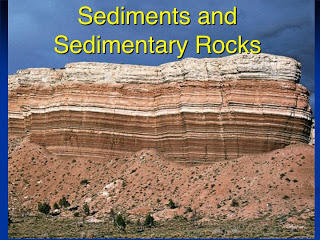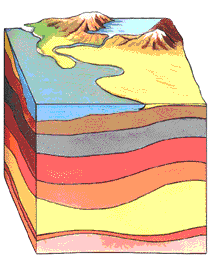Introduction
Rocks are divided into three major types, viz. sedimentary, igneous, and metamorphic. The geologic reactions occurring on the Earth only cause minute alterations to the landscape in a given lifetime. The changes become evident after millions of years. Though gradual, the geologic processes can reduce a mountain to a plain.
The geologic processes lead to the erosion of debris, which is then transferred to form deposits of sedimentary rock. In essence, sedimentary rocks exist at the cost of other rocks that break down through weathering and they are carried by various agents such as wind and deposited to form the rock.
Sedimentary Rocks: overview
Sedimentary rocks can form a string of layers, which can total up to thousands of meters in breadth. By examining these rock layers, geologists can retrieve information about the background of the Earth. The magnitude of information about the Earth’s background is tremendous. Every rock layer marks an age of geological process.
Moreover, the information retrieved in line with its texture, formation, and remnants is crucial for global modification, thus revealing the nature in which the earth changes from the past, present, and future.
For a geologist to study the sedimentary data properly, s/he should comprehend the contemporary sedimentary structures, their sources, mode of transit, and areas or regions where the sediments are currently settling (Stille 56). A research on the ongoing sediment formation and depositing will help one to have a clear view.
The nature of the fossil recorded in the sedimentary rocks gives a glimpse on surrounding where the sediments settled and the process and timeline of how the Earth developed and transformed over time.
Other than the scientific importance, sedimentary rocks also play a great role in industrial and social development. Sedimentary can be used to make various tools that are useful in accomplishing a variety of tasks. This aspect was recorded as early as in the Neolithic Age when early man made tools such as axes and arrowheads using sedimentary rocks.
Some of the statues include those designed during the Renaissance and art in ancient Greek. Notably, about 90% of the known minerals are found within sedimentary rock layers. Oil, coal, cement (sand, limestone, and gravel) and fertilizer is all but a product of sedimentary rocks.
Moreover, sedimentary rocks store a lot of water that people depend on for survival. Indeed, the significance of sedimentary rocks cannot be ignored.
Nature of Sedimentary Rocks
The constitution of sedimentary rocks is derived from mechanical and chemical breakdown of other rocks. The deposit is compressed to solid rock layers made up of organic substances, chemical remains, and pieces of minerals. One can have a good observation of sedimentary rocks by visiting the Grand Canyon in Arizona.
One of the common characteristics is that they have distinct layers known as strata measuring about 100m thick with each layer having disparate and unique texture coupled with internal and external construction.

The texture is often composed of minerals and pieces of rocks implying that abrasion must occur during its formation. The bedding planes (which separate the different layers) often have ripple marks as well as other facts that show that there were water deposition stored along the bedding plane.
Sedimentary rocks are present throughout the world and they form about 75% of the entire world (Tucker 56). The ocean floor is often covered with sedimentary rock layer.
Types of Sedimentary Rocks
There are two types of sedimentary rocks with a distinction on their texture and composition. These two groups include clastic rocks and chemical rocks.
Clastic sedimentary rocks refer to rocks that were formed out of fragmental materials that were transferred and subsequently deposited in the environment of deposition. Essentially, clastic is derived from a Greek word klastos, which means broken. The clastic rocks are further classified by considering the nature of grains.
They are of three types, viz. conglomerate, sandstone, and mudrock with grain size descending respectively. The size of grain in clastic is always determined by the size of the preexisting rock as well as the capability of the transport agent (wind and water).
Deposition occurs when the velocity of the transporting reduces. If the transporting agent were moving fast, then it is anticipated that particles deposited will be coarser than those being moved slowly.

Conglomerate is made up of large grains with sand particles and mud occupying the spaces created by the grains. Naturally, they are smooth and coarsely stratified. They are currently found in the bases of most mountains as well as stream paths. Sandstones are popularly known by most because they are easily observable and are anti-weathering.
They made up of almost anything and they appear in a range of colors (Sohn and Wright 49). Mudrocks are composed of very small grain particles and they are the most dominant in the family of clastic rocks. Due to their smoothness of the grains, they break down easily and create slopes and they are commonly deposited along deltas as well as river floodplains.
Chemical Sedimentary Rocks
Chemical sedimentary rocks develop when chemical reactions lead to the removal of ions from water to form solid substances. Unlike clastic rocks, chemical rocks are grouped according to the composition. Some of the popular chemical sedimentary rocks include limestone, dolostone, and chert. Limestone is the most common and dominant chemical sedimentary rock.
Its constituents include calcium carbonate and it is formed via both chemical and biochemical procedures. The disparate textures of limestone have led to its further categorization to include skeletal, oolitic, and microcrystalline limestone. Skeletal limestone includes chalk, which is made of plants, and animals remain (Tucker 105).
Dolostone closely resembles limestone. It has a light gray color and it can be formed through precipitation and chemical reaction between water having magnesium components and calcium carbonate present in limestone. A third type of chemical and biochemical sedimentary rock is chert ,which is made up of microcrystalline quartz.
It has a granular texture and it breaks like a glass. It has an array of colors and the different colors are often given specific names. For instance, a red chert is referred to as jasper. Its characteristic nature to break and form sharp edges inspired many traditional artists to use it to design arrowheads, spears and other tools (Sohn and Wright 78).
Conclusion
Geological processes are incessantly taking place in various places. Inasmuch as one cannot notice the effects ongoing processes, millions years later, another generation will be living in a new world with different sedimentary structures. As noted in the discussion, sedimentary rocks are formed from weathering of rocks both chemically and mechanically.
The nature of this formation leads to a further classification to clastic and chemical sedimentary rocks. Most of the essential minerals such as diamonds and limestone that people rely on for survival and luxury are found within these rocks.
The significance of sedimentary rocks shows how vital people should be imparted with geological knowledge and in particular that of rocks.
Works Cited
Civil: Sedimentary rocks 2011. Web.
Rock Hounds: How sedimentary rock is formed 2013. Web.
Sohn, Emily, and Pam Wright. Earth Materials: The Mystery Rocks. Chicago: Norwood House Press, 2011. Print.
Stille, Darlene. Sedimentary Rocks: A Record of Earth’s History. Chicago: Capstone, 2008. Print.
Tucker, Maurice. Sedimentary Rocks in the Field: A Practical Guide. London: John Wiley & Sons, 2011. Print.